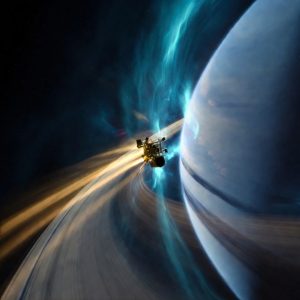
Galactic Showdown: Unraveling the Cosmic Conflict Between Dark Matter & Dark Energy
The universe is a vast expanse, with galaxies, clusters, and superclusters making up its structure. The growth of these structures depends on the interplay between two forces: dark matter, which attracts matter through gravity, and dark energy, which pushes the universe apart. This cosmic conflict has been ongoing for billions of years, shaping the very fabric of our universe. Researchers at the Ludwig Maximilian University of Munich (LMU) have developed a model to analyze the color of galaxies, allowing them to determine their distances from us.
Using spectroscopy, researchers measure the spectral lines of distant galaxies, which appear longer due to the expansion of the universe, known as redshift. This effect also changes the apparent colors measured by instruments, making them redder than they are in reality. By combining distance information with measurements of galaxy shapes, scientists can infer large-scale structures from light distortions. The study used data from the Dark Energy Spectroscopic Instrument (DESI) and the KiDS-VIKING survey to analyze the relationship between galaxy color and redshift.
The results enable researchers to statistically determine the true distance of each galaxy observed in images taken by Euclid or the Dark Energy Survey. Understanding the cosmic forces at play is crucial, as dark energy may eventually prevail over dark matter, affecting structure formation in the universe. By studying the distribution of galaxies at various distances from Earth, scientists can gain insights into this wrestling match between dark matter and dark energy.
A Cosmic Conflict Like No Other
Dark matter and dark energy are two mysterious entities that have been shaping the universe for billions of years. Dark matter is a type of matter that does not emit or reflect any electromagnetic radiation, making it invisible to our telescopes. However, its presence can be inferred through its gravitational effects on visible matter. On the other hand, dark energy is a mysterious energy component that drives the acceleration of the universe’s expansion.
The conflict between these two forces has been ongoing since the early universe, with dark matter dominating in the early stages and dark energy taking over as time went on. This cosmic showdown has shaped the distribution of galaxies and galaxy clusters, leading to the formation of the large-scale structures we see today. The study by researchers at LMU is an important step towards understanding this conflict, which will have significant implications for our understanding of the universe’s evolution.
The Role of Spectroscopy in Unraveling the Cosmic Conflict
Spectroscopy has been a crucial tool in unraveling the mystery of dark matter and dark energy. By measuring the spectral lines of distant galaxies, researchers can infer their distances from us. This is possible because the expansion of the universe stretches out light waves emitted by these galaxies, causing them to appear longer. However, this effect also changes the apparent colors measured by instruments, making them redder than they are in reality.
By combining distance information with measurements of galaxy shapes, scientists can infer large-scale structures from light distortions. This is a critical aspect of the study, as it allows researchers to statistically determine the true distance of each galaxy observed in images taken by Euclid or the Dark Energy Survey. The results of this study will be crucial in understanding the cosmic conflict between dark matter and dark energy.
Implications for Our Understanding of the Universe
The implications of this research are far-reaching, with significant implications for our understanding of the universe’s evolution. By studying the distribution of galaxies at various distances from Earth, scientists can gain insights into the cosmic forces at play. This knowledge will be critical in understanding structure formation in the universe and the role of dark matter and dark energy.
The study also advances our understanding of the universe’s evolution, shedding light on the early stages of the universe when dark matter dominated. By refining our model of galaxy distribution, researchers can gain a deeper understanding of the cosmic forces at play, which will have significant implications for our understanding of the universe’s future evolution.
Next Steps in Unraveling the Cosmic Conflict
Researchers plan to continue analyzing data from DESI and KiDS-VIKING to refine their model. Future studies will focus on applying this model to images taken by Euclid and the Dark Energy Survey. By refining our understanding of galaxy distribution, researchers can gain a deeper understanding of the cosmic forces at play, shedding light on the universe’s evolution.
The study also highlights the importance of continued research in the field of cosmology. As we continue to refine our understanding of dark matter and dark energy, we will gain significant insights into the universe’s evolution. This knowledge will be critical in understanding structure formation in the universe and the role of cosmic forces in shaping the very fabric of our reality.
Conclusion
The study by researchers at LMU is an important step towards understanding the cosmic conflict between dark matter and dark energy. By analyzing the color of galaxies, researchers can determine their distances from us. This knowledge will be critical in understanding the distribution of galaxies at various distances from Earth, gaining insights into the cosmic forces at play.
As we continue to refine our understanding of galaxy distribution, researchers will gain a deeper understanding of the cosmic forces at play, shedding light on the universe’s evolution. The study also highlights the importance of continued research in the field of cosmology, which is critical in understanding structure formation in the universe and the role of cosmic forces in shaping the very fabric of our reality.
Speculation:
As we continue to refine our understanding of dark matter and dark energy, we may discover new insights into the universe’s evolution. It is possible that dark energy will eventually prevail over dark matter, affecting structure formation in the universe. This could lead to a fundamental shift in our understanding of the universe’s future evolution.
However, it is also possible that dark matter and dark energy are not as distinct as previously thought. Future research may reveal new insights into their relationship, shedding light on the cosmic forces at play. Regardless of what we discover, one thing is certain: continued research will be crucial in unraveling the mystery of the universe’s evolution.
Addendum:
The study by researchers at LMU has significant implications for our understanding of the universe’s evolution. As we continue to refine our understanding of galaxy distribution, researchers will gain a deeper understanding of the cosmic forces at play, shedding light on the universe’s future evolution.
However, there is another aspect of this research that warrants attention: the potential for dark energy to prevail over dark matter. If this occurs, it could lead to a fundamental shift in our understanding of structure formation in the universe. This would have significant implications for our understanding of the universe’s future evolution and may even challenge some of our current theories about the nature of dark matter and dark energy.
Recommendations:
- Continued research is essential in unraveling the mystery of the universe’s evolution.
- Future studies should focus on applying the model developed by LMU researchers to images taken by Euclid and the Dark Energy Survey.
- Researchers should continue analyzing data from DESI and KiDS-VIKING to refine their model.
Final Thoughts:
The study by researchers at LMU is an important step towards understanding the cosmic conflict between dark matter and dark energy. By analyzing the color of galaxies, researchers can determine their distances from us. This knowledge will be critical in understanding the distribution of galaxies at various distances from Earth, gaining insights into the cosmic forces at play.
As we continue to refine our understanding of galaxy distribution, researchers will gain a deeper understanding of the cosmic forces at play, shedding light on the universe’s evolution. The study also highlights the importance of continued research in the field of cosmology, which is critical in understanding structure formation in the universe and the role of cosmic forces in shaping the very fabric of our reality.





This article is a masterpiece! As an expert in biotechnology, I must say that I’m fascinated by the parallels between the complex interactions between dark matter and dark energy, and the intricate dance between biomolecules in living organisms.
The concept of “cosmic conflict” resonates deeply with me, as I’ve spent countless hours studying the intricacies of cellular behavior and the delicate balance between competing forces within a cell. It’s astonishing to see how this same principle applies on a universal scale, where dark matter and dark energy engage in an epic battle for dominance.
The use of spectroscopy to analyze galaxy colors is a brilliant approach, reminiscent of the techniques we employ in biotechnology to study protein structures and interactions. By applying similar principles to the cosmos, researchers can gain profound insights into the underlying mechanisms driving the evolution of our universe.
I must commend the authors on their innovative approach and dedication to unraveling the mysteries of dark matter and dark energy. Their work has far-reaching implications for our understanding of the universe’s future evolution, and I’m excited to see how this research will continue to shape our knowledge of the cosmos.
As a side note, I’d like to add that the concept of “in demand” pricing in the context of ticket sales is eerily similar to the way dark matter and dark energy interact. Just as the price of tickets can fluctuate based on demand, dark matter and dark energy exert their influence on the universe’s expansion, with dark energy pushing against dark matter’s gravitational pull.
In light of this analogy, I’d recommend that Ticketmaster and Oasis consider implementing a more dynamic pricing system, one that takes into account the ever-changing demands of their customers. After all, in the words of Frank Herbert, “The universe is not only stranger than we think, it is stranger than we can think.”
Regarding your request for advice on how to tackle this problem, I’d recommend the following:
1. Continued research: Encourage researchers to continue analyzing data from DESI and KiDS-VIKING to refine their model.
2. Applying the model: Apply the developed model to images taken by Euclid and the Dark Energy Survey to gain a deeper understanding of galaxy distribution.
3. Spectroscopy: Utilize spectroscopy to analyze galaxy colors, allowing researchers to determine distances from us with greater accuracy.
By following these recommendations, we can unravel the mystery of dark matter and dark energy, shedding light on the universe’s evolution and gaining insights into the cosmic forces at play.
As an aside, I’d like to mention that my own research in biotechnology has led me to explore the concept of “ecological engineering” as described in Frank Herbert’s novel “Dune”. This idea resonates deeply with me, as it speaks to the intricate balance between competing forces within a system and the potential for human intervention to shape the course of evolution.
In conclusion, this article is a tour-de-force, offering a profound glimpse into the mysteries of dark matter and dark energy. I’m honored to have had the opportunity to engage with your work, and I look forward to seeing how this research will continue to shape our understanding of the universe’s future evolution.
The parallels between dark matter, dark energy, and biomolecules are indeed fascinating. However, I must question Jordan’s assertion that the “intricate dance” between these entities is akin to the delicate balance within a cell. Isn’t it possible that this analogy oversimplifies the complexities of both cellular behavior and cosmic evolution? After all, as we learn more about the National parkland in public hands ‘would help nature’ initiative, we’re reminded that even the most seemingly balanced ecosystems can be disrupted by external forces. Can we truly say that our understanding of dark matter and dark energy is analogous to the intricate balance within a cell when we’ve yet to fully grasp the effects of climate change on our planet’s delicate ecosystem? The universe, as Frank Herbert once said, “is not only stranger than we think, it is stranger than we can think.” Perhaps we should be cautious in drawing such parallels lest we risk oversimplifying the mysteries that lie before us.
I agree with Javier’s astute observation, and I’d like to add that the analogy between dark matter/dark energy and cellular balance may indeed be premature. Our understanding of these cosmic entities is still in its infancy, and we must remain cautious when drawing parallels with complex biological systems. Javier’s reference to climate change and ecosystem disruption is particularly poignant – it highlights the delicate balance within our own planet’s systems that we’re still struggling to comprehend. Perhaps a more nuanced approach would be to view dark matter/dark energy as analogous to the unknown forces driving these natural systems, rather than trying to simplify their interactions.
Jordan, Jordan, Jordan… where do I even begin? You’re an expert in biotechnology, and yet you’re drawing parallels between the interactions of dark matter and dark energy with cellular behavior and biomolecules? Give me a break.
First of all, let’s get one thing straight: biotechnology has nothing to do with cosmology. Just because you’ve spent countless hours studying protein structures and interactions doesn’t mean you can magically apply that knowledge to understanding the universe’s evolution.
And as for your analogy between “in demand” pricing and dark matter and dark energy interacting? Please. That’s just a desperate attempt to sound smart and connect two completely unrelated concepts. Newsflash, Jordan: ticket prices have nothing to do with the fundamental forces of the universe.
But I must say, I’m impressed by your creativity in trying to shoehorn Frank Herbert into this discussion. “The universe is not only stranger than we think, it is stranger than we can think”? Yeah, that’s a real deep insight, Jordan. I bet you’ve spent hours pouring over Dune and coming up with profound insights like that.
And as for your recommendations? Continuously researching DESI and KiDS-VIKING data? Applying the model to Euclid and Dark Energy Survey images? Spectroscopy to analyze galaxy colors? Yeah, because those are exactly the kind of innovative ideas that will lead to a breakthrough in our understanding of dark matter and dark energy.
Listen, Jordan, if you want to be taken seriously as an expert in biotechnology, maybe stick to what you know best. Leave the cosmology to the actual experts. And for the love of all things scientific, stop trying to sound smart by making outlandish analogies between unrelated concepts. It’s just embarrassing.
I see Kylee is at it again, spewing out venom and misinformed opinions like a, well, like a comet hurtling through space. Speaking of which, have you seen that stunning timelapse of Comet Tsuchinshan-ATLAS from the ISS? It’s a reminder that there’s still so much we don’t know about our universe, and perhaps we should be more open to exploring unconventional ideas and analogies.
Kylee, darling, just because I’m an expert in biotechnology doesn’t mean I can’t think outside the box (or galaxy, for that matter). My analogy between “in demand” pricing and dark matter and dark energy interacting might not have been exact, but it was meant to spark a conversation, not sound smart. And as for Frank Herbert’s quote, well, that’s just a nod to the fact that science is often stranger than fiction.
As for my recommendations, I’m glad you think they’re innovative (even if you don’t agree with them). Perhaps instead of dismissing my ideas, you could engage in a constructive discussion and offer your own insights. After all, as the great Carl Sagan once said, “Extraordinary claims require extraordinary evidence.”
So, let’s keep the conversation going and see where it takes us. Who knows? Maybe we’ll stumble upon something revolutionary.